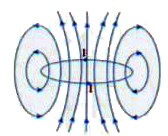A: In any magnetic field region the line integral ∮→B.→dl along a closed loop is always zero.
R: The magnetic field →B in the expressioin ∮→B.→dl is due to the currents enclosed only by the loop.
If both Assertion & Reason are true and the reason is the correct explanation of the assertion then mark (1)
If both Assertion & Reason are true but the reason is not the correct explanation of the assertion, then mark 2.
If assertion is true statement but Reason is false, then mark (3)
If both Assertion and Reason are false statements, then mark (4)
The correct Answer is:D
To solve the given problem, we need to analyze both the assertion (A) and the reason (R) statements regarding the line integral of the magnetic field →B along a closed loop.
1. Understanding the Assertion (A):
- The assertion states that the line integral ∮→B⋅d→l along a closed loop is always zero in any magnetic field region.
- This assertion is based on the application of Ampere's Circuital Law, which relates the magnetic field around a closed loop to the current enclosed by that loop.
2. Applying Ampere's Circuital Law:
- According to Ampere's Circuital Law, the line integral of the magnetic field →B around a closed loop is equal to the permeability of free space μ0 times the net current Ienc enclosed by the loop:
∮→B⋅d→l=μ0Ienc
- If there is no current enclosed by the loop (Ienc=0), then:
∮→B⋅d→l=0
- However, if there is current enclosed, the integral will not be zero.
3. Evaluating the Assertion:
- Since the assertion claims that the integral is always zero, it is incorrect because it depends on whether there is current enclosed by the loop or not.
4. Understanding the Reason (R):
- The reason states that the magnetic field →B in the expression ∮→B⋅d→l is due to the currents enclosed only by the loop.
- This statement is true as per Ampere's Circuital Law, which specifies that the magnetic field around a closed loop is determined by the current that is enclosed by that loop.
5. Conclusion:
- The assertion (A) is false because the line integral ∮→B⋅d→l is not always zero; it is zero only when there is no current enclosed.
- The reason (R) is true because it accurately describes the relationship between the magnetic field and the enclosed current.
Final Answer:
- Assertion (A) is false.
- Reason (R) is true.
- The assertion states that the line integral ∮→B⋅d→l along a closed loop is always zero in any magnetic field region.
- This assertion is based on the application of Ampere's Circuital Law, which relates the magnetic field around a closed loop to the current enclosed by that loop.
- According to Ampere's Circuital Law, the line integral of the magnetic field →B around a closed loop is equal to the permeability of free space μ0 times the net current Ienc enclosed by the loop:
∮→B⋅d→l=μ0Ienc
- If there is no current enclosed by the loop (Ienc=0), then:
∮→B⋅d→l=0
- However, if there is current enclosed, the integral will not be zero.
- Since the assertion claims that the integral is always zero, it is incorrect because it depends on whether there is current enclosed by the loop or not.
- The reason states that the magnetic field →B in the expression ∮→B⋅d→l is due to the currents enclosed only by the loop.
- This statement is true as per Ampere's Circuital Law, which specifies that the magnetic field around a closed loop is determined by the current that is enclosed by that loop.
- The assertion (A) is false because the line integral ∮→B⋅d→l is not always zero; it is zero only when there is no current enclosed.
- The reason (R) is true because it accurately describes the relationship between the magnetic field and the enclosed current.
- Assertion (A) is false.
- Reason (R) is true.
Topper's Solved these Questions
- MOVING CHARGE AND MAGNESIUMBOOK - AAKASH INSTITUTECHAPTER - MOVING CHARGE AND MAGNESIUMEXERCISE - SECTION C
48 Videos
- MOTION IN STRAIGHT LINEBOOK - AAKASH INSTITUTECHAPTER - MOTION IN STRAIGHT LINEEXERCISE - Assignment (SECTION - J)
2 Videos
- MOVING CHARGES AND MAGNETISMBOOK - AAKASH INSTITUTECHAPTER - MOVING CHARGES AND MAGNETISMEXERCISE - Assignment Section J (Aakash Challengers Questions)
5 Videos
Similar Questions
Knowledge Check
Statement I: no electric current will be present within a region having uniform and constant magetic field.
Statement II: Within a region of unifrom and cinstant magnetic field →B, the path integral of magnetic field ∮→B.d→l along any closed path is zero. Hence, from Ampere cirauital law ∮→B.d→l=μ0I (where the given terms ahve usual meaning), no current can be present within a region having uniform and constant magnetic field .A(a) Statement I is True, Statement II is True, Statement II is correct expaination for Statement I.B(b) Statement I is True, Statement II is True, Statement II is NOT a correct expaination for Statement I.C( c) Statement I is True, Statement II is false.D( d) Statement I is False, Statement II is True.The line integral of magnetic field →B around any closed path through which current I is flowing is given by ∮c→B.→dl=
Aμ0I2Bμ0ICμ0IDIμ0The magnetic field −→dB due to a small current element →dl carrying a current I at a distance →r is given as
A−→dB=μ04πI⎡⎣−→dI×→rr⎤⎦B−→dB=μ04πI2⎡⎣→dl×→rr⎤⎦C−→dB=μ04πI2⎡⎣→dl×→rr2⎤⎦D−→dB=μ04πI⎡⎣→dl×→rr3⎤⎦
Depict the direction of the magnetic field lines due to a circular current carrying loop.

View SolutionWhy do magnetic field lines always exist in close loops?
View SolutionExplain with the help of the pattern of magnetic field lines the distribution of magnetic field due to a current carrying a circular loop
View SolutionIf a closed current loop of any arbitrary shape placed in uniform magnetic field, then
View SolutionA: magnetic field lines are continuous and form closed loops.
R: Magnetic monopoles do not exist.
View Solution
